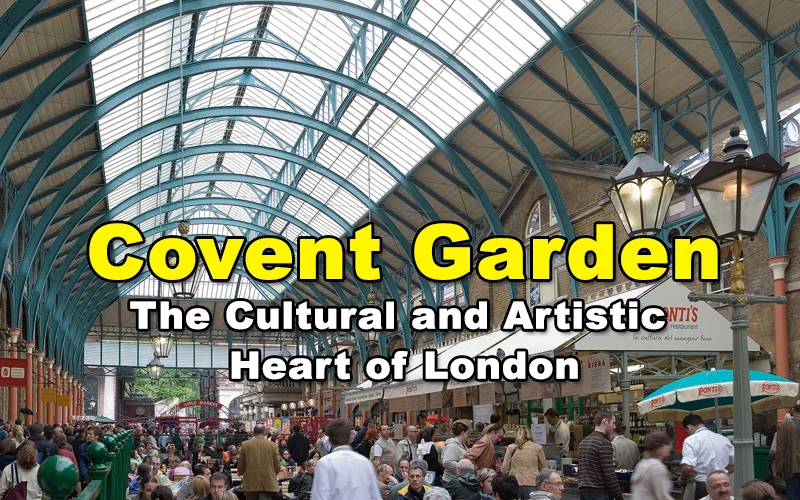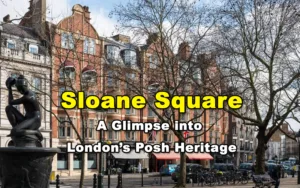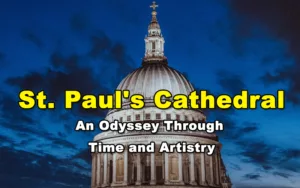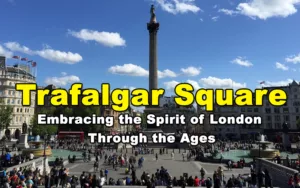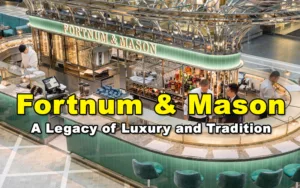Nestled in the bustling heart of London, Covent Garden tells a story that spans centuries, from its humble beginnings as a lush garden plot to its current status as one of the city’s most vibrant and beloved destinations. Originally a patch of green tended by the monks of St. Paul’s Abbey in the 13th century, it transformed into an upscale residential area with a lively open-air market by the 1600s. The market quickly became central to London’s commerce, bustling with traders selling fresh produce and goods.
However, by the 20th century, the market had outstripped its quaint quarters, leading to crowding and logistical issues. A pivotal shift came when the market relocated, allowing Covent Garden to reinvent itself once again. The area blossomed into a retail and entertainment powerhouse, buzzing with shops, eateries, and theatres. Today, it stands as a testament to London’s ability to blend the old with the new, drawing visitors from around the globe with its unique charm and diverse offerings.
Perfectly placed in the West End, in the London Borough of Camden, Covent Garden is a jewel in London’s crown, easily reached by tube, bus, or on foot. The Covent Garden tube station places you right in the centre of the action, while numerous bus routes ensure a smooth journey from anywhere in the city. For those who prefer to meander through London’s streets, many of the city’s most iconic sights are just a stroll away. This prime location and superb connectivity make Covent Garden a hassle-free and must-visit destination for everyone, whether they’re long-time Londoners or first-time visitors.
The Historical Evolution of Covent Garden
The Early Years: Covent Garden as a Convent Garden
Origin of the name “Covent Garden”: Covent Garden’s intriguing name is a nod to its monastic past, tracing back to when it was known as “Convent Garden,” associated with the Abbey of St. Paul. In those medieval times, the space was lush and productive, serving as a kitchen garden to provide the monks of the Abbey with fresh produce, herbs, and other necessities.
Use of the area by the Anglo-Saxons and later by the Normans: The land’s story begins even earlier with the Anglo-Saxons, who utilized this fertile ground for agriculture. Following the Norman Conquest, this agricultural tradition continued, though the land underwent a transformation under the Abbey’s stewardship, gradually emerging as a key player in London’s commercial and cultural life.
The 17th Century: Establishment of the Fruit and Vegetable Market
Description of the market’s role in London’s commerce: Fast forward to the 17th century, and the once Convent Garden had blossomed into a lively open-air market, a heartbeat of London’s bustling trade scene. Farmers and traders from various regions congregated here, selling their goods and contributing to the market’s reputation as one of the city’s crucial commercial hubs.
Architectural developments, including the work of Inigo Jones: This era also saw a significant transformation in the area’s architectural landscape, thanks largely to the visionary Inigo Jones. Commissioned by the 4th Earl of Bedford, Jones introduced a ground breaking public square surrounded by arcades and elegant buildings, infusing Covent Garden with a sense of classical grandeur inspired by his travels in Italy. This move elevated the area’s status, reshaping urban design in London.
The 19th and 20th Centuries: Challenges and Decline faced by Covent Garden
A discussion of the challenges faced by Covent Garden market: As the pages of history turned, Covent Garden found itself in a precarious position, wrestling with mounting challenges that put its historical market’s vitality at risk. The iconic piazza, once a symbol of prosperity and lively commerce, was showing signs of strain under the weight of its own success.
The central location, a boon for centuries, had become a source of vulnerability. The surrounding narrow streets, relics of an older London, were ill-equipped to handle the incessant flow of traffic and throngs of visitors drawn to the market each day. This congestion not only hampered the visitor experience but also affected the timely transportation of goods, undermining the efficiency that had once defined the market.
Inside the market, the situation was no less dire. The aging facilities, with their quaint charm, were now impediments to progress. They struggled to accommodate the sheer volume and variety of produce that vendors brought in daily, leading to logistical nightmares and a gradual decline in the quality of goods available. This was not just a blow to the traders but also to the countless Londoners who depended on the market for their fresh produce.
To complicate matters further, the advent of newer, more modern markets and retail spaces across London introduced a level of competition that Covent Garden was ill-prepared to face. These rivals boasted of advanced logistical networks and trading facilities, offering efficiency and convenience that the historic market couldn’t match.
Confronted with a complex array of challenges ranging from logistical headaches and crumbling infrastructure to fierce market competition and the spatial constraints of its historic locale, Covent Garden’s venerable market found itself perched at a critical juncture. As the years of the 20th century ticked by, the once-thriving commercial hub was steeped in a period of uncertainty and introspection.
The task at hand was monumental: to reimagine and revitalize Covent Garden, ensuring its survival and relevance in the face of changing times while paying homage to its rich heritage. The future of this iconic London landmark hung in the balance, awaiting a new chapter that would hopefully secure its place in the city’s heart for generations to come.
The need for transformation was apparent, sparking conversations and plans for how to breathe new life into this cherished area.
Yet, within these challenges lay an opportunity—an opportunity to reimagine Covent Garden’s role in contemporary London. The area’s undeniable charisma and historical allure were assets that, if leveraged correctly, could form the foundation of its revival.
The goal was clear: to transform Covent Garden in a way that struck a delicate balance between preservation and progress.
This required a thoughtful and innovative approach, one that would embrace the area’s storied past while making strategic updates and enhancements to usher it into the 21st century. The vision was for a Covent Garden that retained its soul and character, yet stood ready to thrive and captivate the imaginations of future generations, ensuring its continued prosperity and relevance in the vibrant tapestry of London.
The market’s decline and eventual relocation: By the 20th century, it was clear that the market could no longer function effectively in its crammed quarters. After extensive discussions and public deliberations, a bold decision was made to relocate the market to a more spacious area in Nine Elms in 1974. This significant move marked the close of one chapter and the beginning of another, setting the stage for Covent Garden’s renaissance as the lively cultural and commercial epicentre we know today.
Covent Garden Today: A Vibrant Destination
Retail and Dining
Covent Garden today is a pulsating heart in the centre of London, brimming with an extensive variety of retail and culinary delights. The area proudly flaunts a rich tapestry of high-end boutiques, eccentric shops, and iconic flagship stores from around the world, creating a shopping paradise that elegantly marries opulence with the eclectic. On the culinary front, Covent Garden is nothing short of a gastronomic haven, boasting a spectrum of options from fine dining restaurants and chic cafés to vibrant street food stalls and traditional pubs. This diversity offers visitors and locals alike a comprehensive taste of London’s dynamic food scene.
In the vast sea of retail and dining options, certain establishments stand tall, carving out a niche for themselves through their history, popularity, or distinctive offerings. The Apple Market, set within a captivating 19th-century structure, emerges as a treasure trove for those in pursuit of antiques, art, crafts, and unique gifts. Culinary aficionados are spoilt for choice with historic and upscale dining venues like The Ivy and Rules, while places like Dishoom serve as a nod to London’s rich multicultural tapestry, offering a dining experience infused with flavours from across the globe.
Arts and Entertainment
Covent Garden proudly wears its crown as a major artery in the body of London’s theatrical scene, hosting an array of theatres and performance spaces that collectively bolster the city’s reputation as a global cultural powerhouse. The illustrious Royal Opera House stands out, hosting an array of world-class ballet and opera performances, while smaller venues such as the Fortune Theatre and Adelphi Theatre offer a diverse theatrical menu, ranging from compelling dramas to exuberant musicals.
Moving beyond the majestic walls of the theatres, the vibrant and bustling streets of Covent Garden unfold into a spontaneous stage of entertainment, accessible and free for everyone to revel in. The piazza itself transforms into an energetic performance space, showcasing a diverse and ever-changing array of street performers, musicians, and artists.
Each performer brings their unique flair and talent, contributing to and amplifying the lively and spirited ambiance that permeates the area. Passers by might find themselves enchanted by a mesmerizing street magician one moment, and tapping their feet to a live musical performance the next. Artists displaying their craft add strokes of creativity and colour to the scene, ensuring that a walk through Covent Garden is always an encounter with the vibrant heart of live, spontaneous entertainment.
Annual Events and Festivals
Year-round, Covent Garden serves as a festive ground, hosting a varied array of events and festivals that celebrate the arts, culture, and the changing seasons. These occasions offer a golden opportunity for both locals and tourists to immerse themselves in the lively community spirit, enjoy live performances, and partake in celebratory activities.
Among the plethora of events, the Covent Garden Apple Market’s Christmas festivities stand out, transforming the area into a winter wonderland adorned with twinkling lights and festive decorations. Cultural celebrations like the Chinese New Year also paint the streets with colour and energy, featuring vibrant parades and performances. In addition, the area buzzes with seasonal festivals, innovative art installations, and live music events throughout the year, solidifying Covent Garden’s status as a vibrant hub of entertainment and joy, no matter the season.
Architectural and Cultural Significance
Preservation of Historic Buildings
The architectural grandeur of Covent Garden stands as a vibrant reminder of the area’s historical depth and the dedicated efforts made to conserve it. Local authorities, alongside various conservation groups, have been steadfast in their commitment to uphold the architectural integrity of Covent Garden’s historic buildings. They ensure that any updates or developments seamlessly blend with the area’s inherent character. Conservation policies have been crucial in this regard, playing an instrumental role in protecting the architectural heritage and preserving the unique ambiance and aesthetic of Covent Garden.
The Royal Opera House is a shining example of Covent Garden’s architectural treasures, its impressive façade and lavish interiors mirroring the area’s cultural significance. The Market Building, recognizable by its iconic colonnades, stands as another historic landmark, having transitioned from housing the original fruit and vegetable market to now accommodating a diverse array of shops and restaurants. St. Paul’s Church, affectionately termed the Actors’ Church, is distinguished by its classical portico and serene garden, offering a peaceful retreat amidst the energetic buzz of the district.
Covent Garden’s Cultural Impact
Covent Garden’s metamorphosis from a bustling market space to a dynamic cultural and commercial epicentre has profoundly shaped London’s cultural fabric. The area nurtures a flourishing arts scene, underpinning theatres, art galleries, and live performances, all of which contribute to the city’s esteemed standing as a global cultural powerhouse. Covent Garden’s energetic vibe, diverse array of attractions, and historical richness have established it as a cradle of creativity and innovation, setting trends and shaping the arts, fashion, and culinary scenes.
Covent Garden’s storied past includes associations with an array of eminent figures spanning writers, artists, actors, and musicians. Literary icons such as Charles Dickens have captured the essence of the area in their writings, while illustrious actors like Laurence Olivier have illuminated the stages of Covent Garden’s theatres. The locale has also hosted legendary musicians, including the Beatles, who performed at the Royal Opera House in 1963. These connections enrich Covent Garden’s cultural narrative, solidifying its position as an integral component of London’s rich cultural history.
Visitor Information
Getting to and Around Covent Garden
Covent Garden is easily accessible by various modes of transportation, ensuring a hassle-free journey for visitors. The London Underground provides a convenient option, with the Covent Garden tube station situated right in the heart of the district. Alternatively, numerous bus routes serve the area, and for those who prefer to travel on foot, the location’s central position makes it a walkable destination from many other parts of London. For a scenic approach, visitors might also consider taking a riverboat to the nearby Embankment Pier and enjoying a short walk across the Golden Jubilee Bridges.
Covent Garden’s compact size and pedestrian-friendly streets make it easy to explore on foot. Visitors are encouraged to take their time wandering through the charming alleys and courtyards, discovering the various shops, eateries, and performance spaces that are tucked away. Utilizing a map or navigation app can help in finding specific destinations, but part of Covent Garden’s charm lies in its serendipitous discoveries.
Recommendations for Visitors
Beyond the well-known landmarks like the Royal Opera House and the Market Building, visitors should not miss the chance to explore Covent Garden’s hidden gems. Neal’s Yard, with its colourful buildings and vibrant atmosphere, is a secluded courtyard that offers a peaceful retreat from the bustling streets. The London Transport Museum provides a fascinating glimpse into the city’s transportation history, while the Covent Garden Piazza is a must-visit for its street performances and lively ambiance.
Covent Garden presents a culinary kaleidoscope, ensuring every visitor finds something to suit their palate and budget. For gastronomy enthusiasts, the area is a treasure trove, boasting an eclectic array of options from upscale restaurants to quaint street food stalls. Begin your gastronomic adventure with a savory meal at one of the esteemed restaurants, and then sweeten the experience with delightful treats from various bakeries and dessert parlors.
On the shopping front, Covent Garden does not disappoint. The district is sprinkled with an assortment of retail havens ranging from opulent brand stores to charming independent boutiques. For those seeking a shopping experience with a twist, the Apple Market is the go-to spot, offering a variety of antiques, art pieces, and crafts that make for perfect, unique souvenirs.
To fully soak in the vibrant ambiance of Covent Garden without the bustling crowds, consider scheduling your visit during the weekdays or opting for an early morning adventure. This way, you can leisurely explore and enjoy all the dining and shopping delights that Covent Garden has to offer.
Summing Up Covent Garden
Covent Garden serves as a living testament to London’s enduring capacity to honour its historic roots while seamlessly adapting to the contemporary demands of both its residents and visitors. With a lineage tracing back to its initial establishment as a Convent Garden, catering to the Abbey of St. Paul, through its bustling epoch as a central fruit and vegetable market, right up to its current incarnation as a thriving cultural and commercial hub, Covent Garden has consistently played a pivotal role in shaping the city’s narrative over the centuries.
The area is a veritable tapestry of time, with its historic buildings and structures meticulously preserved through vigilant conservation efforts, providing a tangible connection to the past. Concurrently, the vibrant array of shops, eateries, and entertainment venues mirror London’s diverse and dynamic nature. The unwavering dedication to preserving the architectural heritage of Covent Garden, intertwined with a constant infusion of creativity and innovation, ensures that the area remains as vivacious and pertinent in contemporary times as it has been throughout history.
Covent Garden stands as a striking testament to London’s rich historical tapestry and vibrant contemporary culture, establishing itself as an essential destination for anyone seeking to fully experience the city. It is a unique locale where history is not just remembered, but vividly alive, creating a multifaceted experience that appeals to history aficionados, art enthusiasts, culinary adventurers, and dedicated shoppers alike.
With its easily navigable and pedestrian-friendly layout, visitors are invited to dive deep into the Covent Garden experience, discovering its many hidden treasures and basking in its electrifying atmosphere. From its historical allure and cultural treasures to its gastronomic delights and shopping extravaganzas, Covent Garden encapsulates the singular charm and vitality that make London such a unique and enticing city.
In essence, Covent Garden is more than just a destination; it is a living, breathing experience, a vital piece of London’s soul, and an energetic chapter in the city’s unfolding narrative. Each visit unveils new layers, and the area’s perpetual vibrancy ensures there is always something new to discover and reasons aplenty to return. In conclusion, Covent Garden stands as a beacon of London’s enduring spirit, a vibrant and essential chapter in the ongoing story of this remarkable city.
“I may earn commissions as an affiliate from sponsored links within this post”


